Yunlu Xu
Distilling Object Detectors With Global Knowledge
Oct 17, 2022
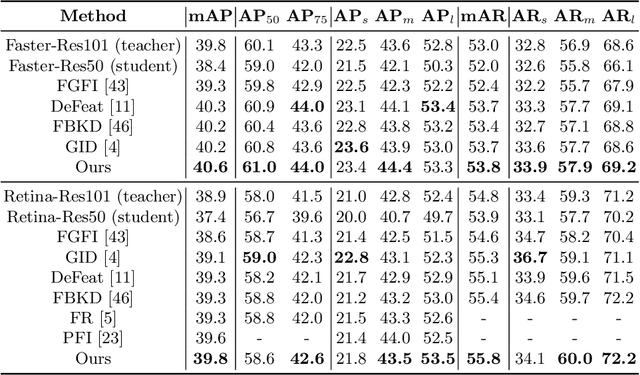
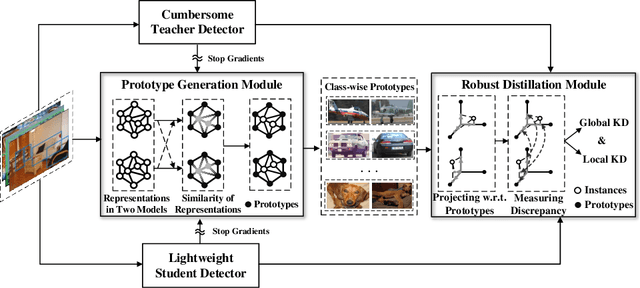
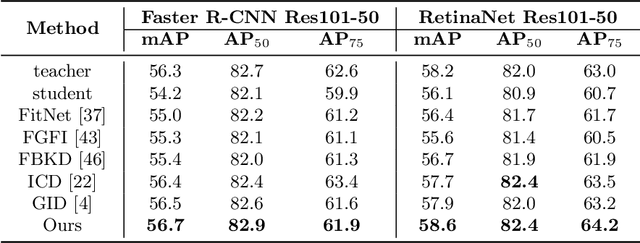
Abstract:Knowledge distillation learns a lightweight student model that mimics a cumbersome teacher. Existing methods regard the knowledge as the feature of each instance or their relations, which is the instance-level knowledge only from the teacher model, i.e., the local knowledge. However, the empirical studies show that the local knowledge is much noisy in object detection tasks, especially on the blurred, occluded, or small instances. Thus, a more intrinsic approach is to measure the representations of instances w.r.t. a group of common basis vectors in the two feature spaces of the teacher and the student detectors, i.e., global knowledge. Then, the distilling algorithm can be applied as space alignment. To this end, a novel prototype generation module (PGM) is proposed to find the common basis vectors, dubbed prototypes, in the two feature spaces. Then, a robust distilling module (RDM) is applied to construct the global knowledge based on the prototypes and filtrate noisy global and local knowledge by measuring the discrepancy of the representations in two feature spaces. Experiments with Faster-RCNN and RetinaNet on PASCAL and COCO datasets show that our method achieves the best performance for distilling object detectors with various backbones, which even surpasses the performance of the teacher model. We also show that the existing methods can be easily combined with global knowledge and obtain further improvement. Code is available: https://github.com/hikvision-research/DAVAR-Lab-ML.
E2-AEN: End-to-End Incremental Learning with Adaptively Expandable Network
Jul 14, 2022



Abstract:Expandable networks have demonstrated their advantages in dealing with catastrophic forgetting problem in incremental learning. Considering that different tasks may need different structures, recent methods design dynamic structures adapted to different tasks via sophisticated skills. Their routine is to search expandable structures first and then train on the new tasks, which, however, breaks tasks into multiple training stages, leading to suboptimal or overmuch computational cost. In this paper, we propose an end-to-end trainable adaptively expandable network named E2-AEN, which dynamically generates lightweight structures for new tasks without any accuracy drop in previous tasks. Specifically, the network contains a serial of powerful feature adapters for augmenting the previously learned representations to new tasks, and avoiding task interference. These adapters are controlled via an adaptive gate-based pruning strategy which decides whether the expanded structures can be pruned, making the network structure dynamically changeable according to the complexity of the new tasks. Moreover, we introduce a novel sparsity-activation regularization to encourage the model to learn discriminative features with limited parameters. E2-AEN reduces cost and can be built upon any feed-forward architectures in an end-to-end manner. Extensive experiments on both classification (i.e., CIFAR and VDD) and detection (i.e., COCO, VOC and ICCV2021 SSLAD challenge) benchmarks demonstrate the effectiveness of the proposed method, which achieves the new remarkable results.
TRIE++: Towards End-to-End Information Extraction from Visually Rich Documents
Jul 14, 2022
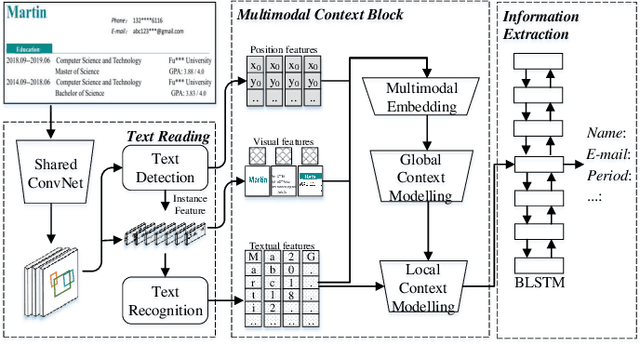

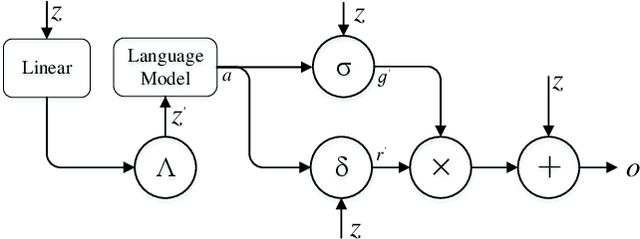
Abstract:Recently, automatically extracting information from visually rich documents (e.g., tickets and resumes) has become a hot and vital research topic due to its widespread commercial value. Most existing methods divide this task into two subparts: the text reading part for obtaining the plain text from the original document images and the information extraction part for extracting key contents. These methods mainly focus on improving the second, while neglecting that the two parts are highly correlated. This paper proposes a unified end-to-end information extraction framework from visually rich documents, where text reading and information extraction can reinforce each other via a well-designed multi-modal context block. Specifically, the text reading part provides multi-modal features like visual, textual and layout features. The multi-modal context block is developed to fuse the generated multi-modal features and even the prior knowledge from the pre-trained language model for better semantic representation. The information extraction part is responsible for generating key contents with the fused context features. The framework can be trained in an end-to-end trainable manner, achieving global optimization. What is more, we define and group visually rich documents into four categories across two dimensions, the layout and text type. For each document category, we provide or recommend the corresponding benchmarks, experimental settings and strong baselines for remedying the problem that this research area lacks the uniform evaluation standard. Extensive experiments on four kinds of benchmarks (from fixed layout to variable layout, from full-structured text to semi-unstructured text) are reported, demonstrating the proposed method's effectiveness. Data, source code and models are available.
DavarOCR: A Toolbox for OCR and Multi-Modal Document Understanding
Jul 14, 2022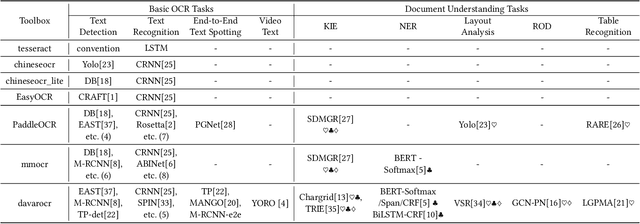

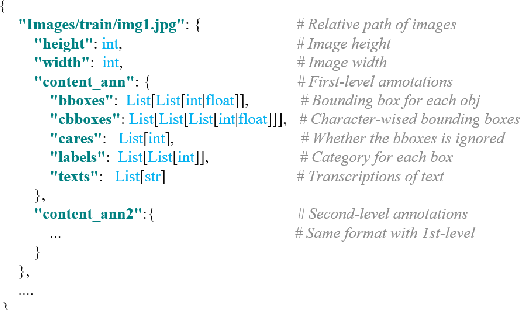
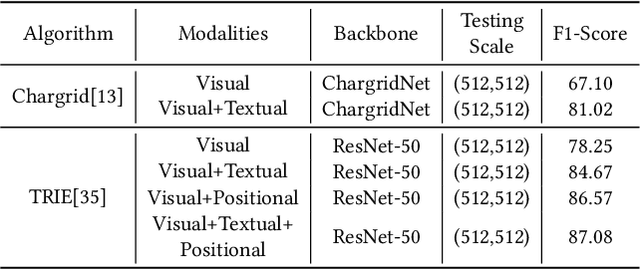
Abstract:This paper presents DavarOCR, an open-source toolbox for OCR and document understanding tasks. DavarOCR currently implements 19 advanced algorithms, covering 9 different task forms. DavarOCR provides detailed usage instructions and the trained models for each algorithm. Compared with the previous opensource OCR toolbox, DavarOCR has relatively more complete support for the sub-tasks of the cutting-edge technology of document understanding. In order to promote the development and application of OCR technology in academia and industry, we pay more attention to the use of modules that different sub-domains of technology can share. DavarOCR is publicly released at https://github.com/hikopensource/Davar-Lab-OCR.
Technical Report for ICCV 2021 Challenge SSLAD-Track3B: Transformers Are Better Continual Learners
Jan 13, 2022

Abstract:In the SSLAD-Track 3B challenge on continual learning, we propose the method of COntinual Learning with Transformer (COLT). We find that transformers suffer less from catastrophic forgetting compared to convolutional neural network. The major principle of our method is to equip the transformer based feature extractor with old knowledge distillation and head expanding strategies to compete catastrophic forgetting. In this report, we first introduce the overall framework of continual learning for object detection. Then, we analyse the key elements' effect on withstanding catastrophic forgetting in our solution. Our method achieves 70.78 mAP on the SSLAD-Track 3B challenge test set.
A Strong Baseline for Semi-Supervised Incremental Few-Shot Learning
Nov 04, 2021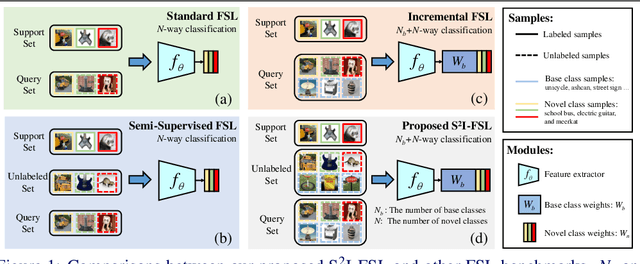
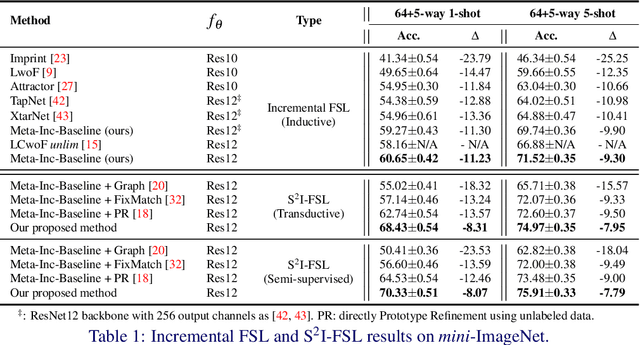

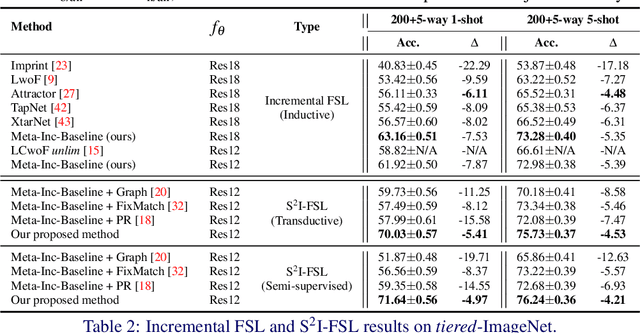
Abstract:Few-shot learning (FSL) aims to learn models that generalize to novel classes with limited training samples. Recent works advance FSL towards a scenario where unlabeled examples are also available and propose semi-supervised FSL methods. Another line of methods also cares about the performance of base classes in addition to the novel ones and thus establishes the incremental FSL scenario. In this paper, we generalize the above two under a more realistic yet complex setting, named by Semi-Supervised Incremental Few-Shot Learning (S2 I-FSL). To tackle the task, we propose a novel paradigm containing two parts: (1) a well-designed meta-training algorithm for mitigating ambiguity between base and novel classes caused by unreliable pseudo labels and (2) a model adaptation mechanism to learn discriminative features for novel classes while preserving base knowledge using few labeled and all the unlabeled data. Extensive experiments on standard FSL, semi-supervised FSL, incremental FSL, and the firstly built S2 I-FSL benchmarks demonstrate the effectiveness of our proposed method.
Reciprocal Feature Learning via Explicit and Implicit Tasks in Scene Text Recognition
May 13, 2021

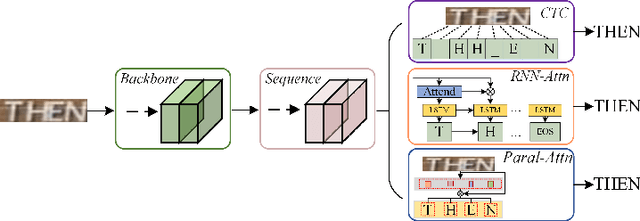

Abstract:Text recognition is a popular topic for its broad applications. In this work, we excavate the implicit task, character counting within the traditional text recognition, without additional labor annotation cost. The implicit task plays as an auxiliary branch for complementing the sequential recognition. We design a two-branch reciprocal feature learning framework in order to adequately utilize the features from both the tasks. Through exploiting the complementary effect between explicit and implicit tasks, the feature is reliably enhanced. Extensive experiments on 7 benchmarks show the advantages of the proposed methods in both text recognition and the new-built character counting tasks. In addition, it is convenient yet effective to equip with variable networks and tasks. We offer abundant ablation studies, generalizing experiments with deeper understanding on the tasks. Code is available.
MANGO: A Mask Attention Guided One-Stage Scene Text Spotter
Dec 08, 2020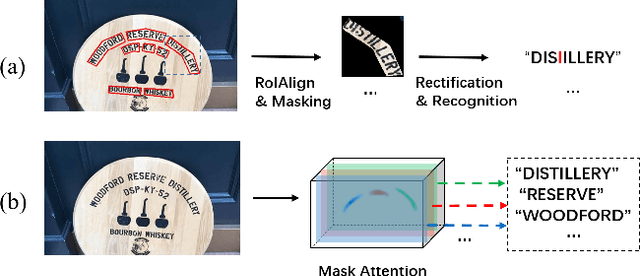
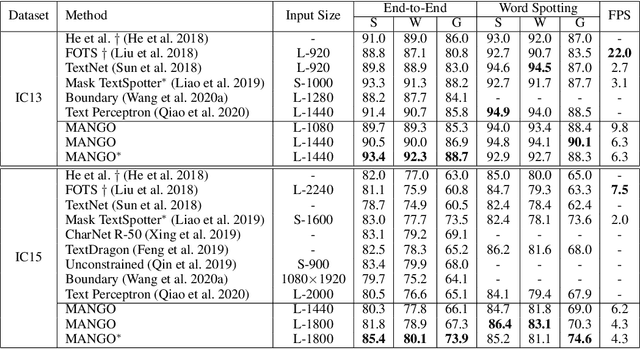
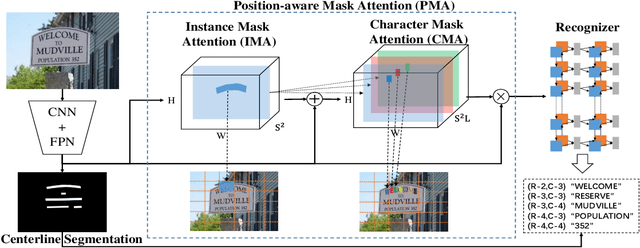
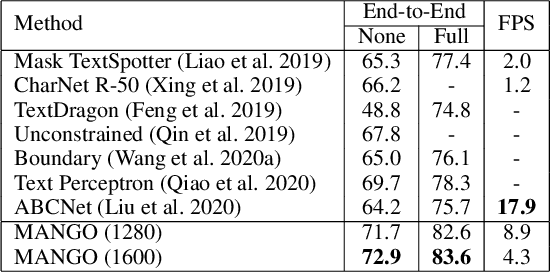
Abstract:Recently end-to-end scene text spotting has become a popular research topic due to its advantages of global optimization and high maintainability in real applications. Most methods attempt to develop various region of interest (RoI) operations to concatenate the detection part and the sequence recognition part into a two-stage text spotting framework. However, in such framework, the recognition part is highly sensitive to the detected results (\emph{e.g.}, the compactness of text contours). To address this problem, in this paper, we propose a novel Mask AttentioN Guided One-stage text spotting framework named MANGO, in which character sequences can be directly recognized without RoI operation. Concretely, a position-aware mask attention module is developed to generate attention weights on each text instance and its characters. It allows different text instances in an image to be allocated on different feature map channels which are further grouped as a batch of instance features. Finally, a lightweight sequence decoder is applied to generate the character sequences. It is worth noting that MANGO inherently adapts to arbitrary-shaped text spotting and can be trained end-to-end with only coarse position information (\emph{e.g.}, rectangular bounding box) and text annotations. Experimental results show that the proposed method achieves competitive and even new state-of-the-art performance on both regular and irregular text spotting benchmarks, i.e., ICDAR 2013, ICDAR 2015, Total-Text, and SCUT-CTW1500.
TRIE: End-to-End Text Reading and Information Extraction for Document Understanding
May 27, 2020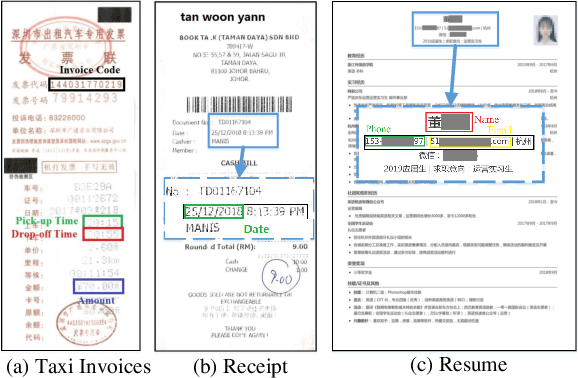
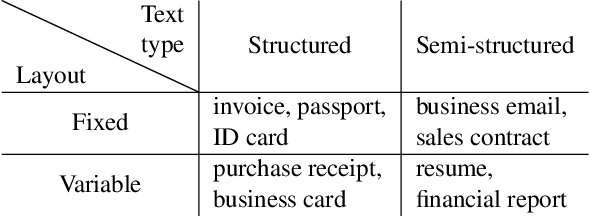
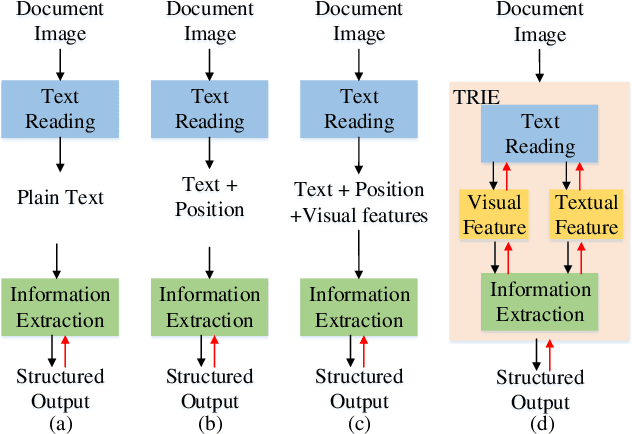
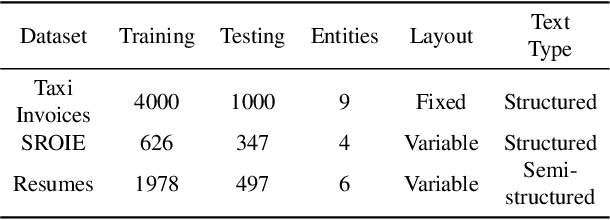
Abstract:Since real-world ubiquitous documents (e.g., invoices, tickets, resumes and leaflets) contain rich information, automatic document image understanding has become a hot topic. Most existing works decouple the problem into two separate tasks, (1) text reading for detecting and recognizing texts in the images and (2) information extraction for analyzing and extracting key elements from previously extracted plain text. However, they mainly focus on improving information extraction task, while neglecting the fact that text reading and information extraction are mutually correlated. In this paper, we propose a unified end-to-end text reading and information extraction network, where the two tasks can reinforce each other. Specifically, the multimodal visual and textual features of text reading are fused for information extraction and in turn, the semantics in information extraction contribute to the optimization of text reading. On three real-world datasets with diverse document images (from fixed layout to variable layout, from structured text to semi-structured text), our proposed method significantly outperforms the state-of-the-art methods in both efficiency and accuracy.
SPIN: Structure-Preserving Inner Offset Network for Scene Text Recognition
May 27, 2020



Abstract:Arbitrary text appearance poses a great challenge in scene text recognition tasks. Existing works mostly handle with the problem in consideration of the shape distortion, including perspective distortions, line curvature or other style variations. Therefore, methods based on spatial transformers are extensively studied. However, chromatic difficulties in complex scenes have not been paid much attention on. In this work, we introduce a new learnable geometric-unrelated module, the Structure-Preserving Inner Offset Network (SPIN), which allows the color manipulation of source data within the network. This differentiable module can be inserted before any recognition architecture to ease the downstream tasks, giving neural networks the ability to actively transform input intensity rather than the existing spatial rectification. It can also serve as a complementary module to known spatial transformations and work in both independent and collaborative ways with them. Extensive experiments show that the use of SPIN results in a significant improvement on multiple text recognition benchmarks compared to the state-of-the-arts.
 Add to Chrome
Add to Chrome Add to Firefox
Add to Firefox Add to Edge
Add to Edge